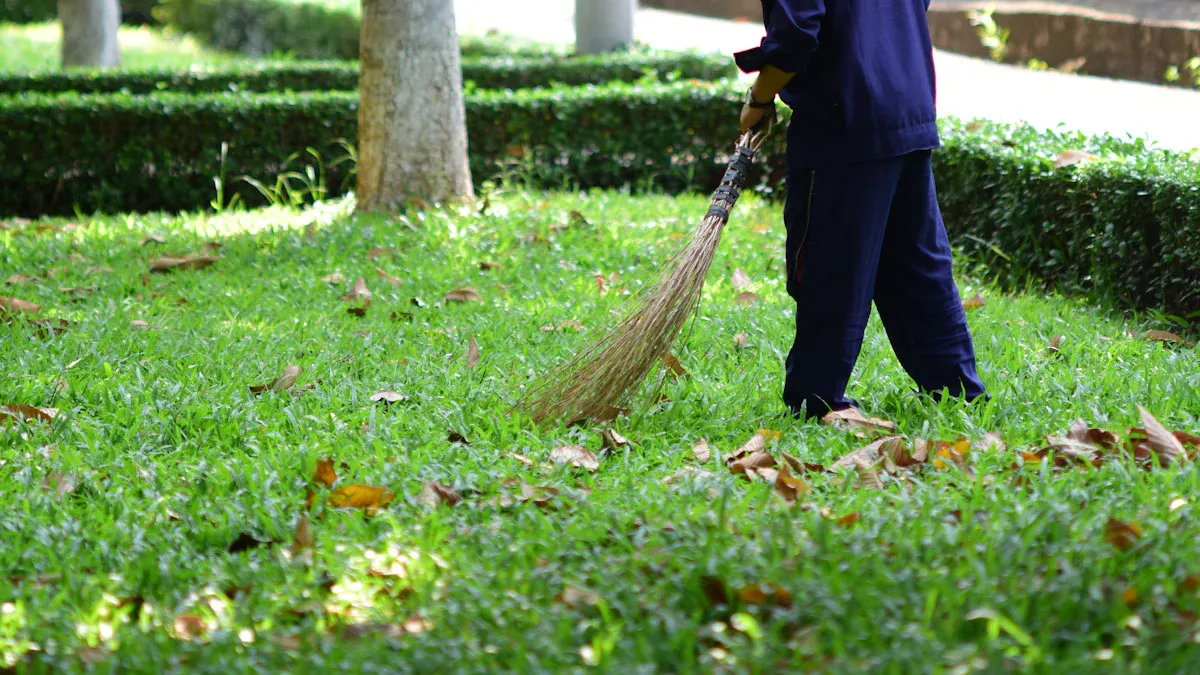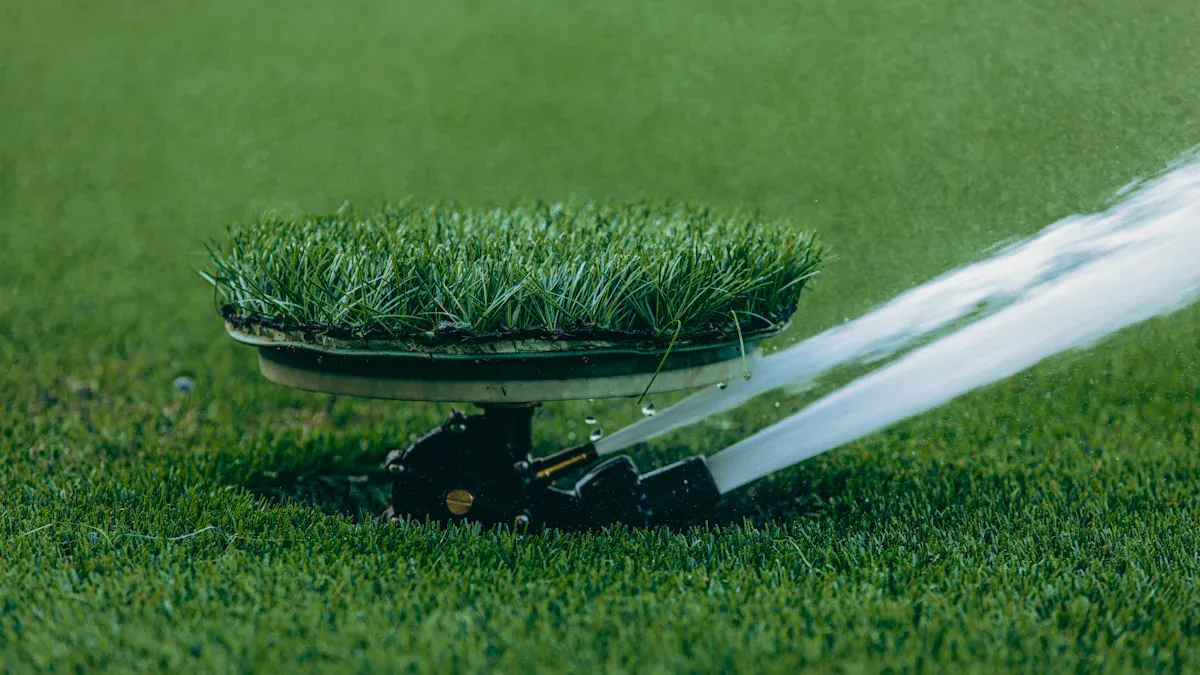Caring for artificial grass takes just a few simple steps. You should brush the fibers every week to keep them standing tall and prevent matting. Rinse the surface every one to two weeks to remove dust and pollen. Remove leaves, twigs, and other debris often to keep the lawn fresh and safe. Regular maintenance helps your lawn look beautiful, last longer, and stay clean for everyone to enjoy. With these easy habits, you can keep your yard in top shape all year.
matters need attention :
- Brush your artificial grass every week. This keeps the fibers standing up. It also stops them from getting flat.
- Rinse the turf every one or two weeks. This helps wash away dust. It also keeps the turf clean.
- Clean up stains right away. Use mild soap and water. This stops stains from staying forever.
- Make sure water can drain well. This stops water from pooling. It helps your lawn stay healthy.
Daily Care

Remove Debris
You should remove debris from your artificial grass at least once a week. Leaves, twigs, and trash can collect quickly, especially in high-traffic areas or during windy days. Regular cleaning helps prevent damage and discoloration.
- Pick up large items by hand.
- Use a leaf blower or a plastic rake for smaller debris.
- Pay extra attention to spots where people walk often.
Tip: Clearing debris often keeps your lawn looking fresh and safe for play.
Brush Fibers
Brushing the fibers helps your artificial grass stay upright and soft. When you brush, you prevent the blades from getting matted down.
- Choose a brush with soft, synthetic bristles. This type protects the grass blades.
- Use a long-handled brush for bigger spaces. A narrow brush works well for corners.
- Brush in different directions to keep the turf looking natural.
- For large lawns, a power brush can save time.
Regular brushing also reduces shine and keeps the turf feeling comfortable. The right broom makes a big difference in how your lawn looks after installation.
Quick Clean
Quick cleaning keeps your artificial grass in top shape after heavy use or events.
- Pick up trash and large debris right away.
- Rinse the area with a garden hose, especially if pets use the lawn.
- Brush the grass to lift any fibers that look flat.
- Spot clean stains with mild soap and warm water.
If you notice strong odors, use a turf-safe cleaner with enzymes or a synthetic turf deodorizer. Clean up spills and pet waste immediately to prevent stains and bacteria buildup. Rinse the spot with water after removing solid waste.
Note: Weekly cleaning is best for lawns that get lots of use. Rinse twice a month if your yard is quieter.
Artificial Grass Cleaning

Stain Removal
You will sometimes find stains on your artificial grass. Food spills, drinks, and even mud can leave marks. You can keep your lawn looking fresh by acting quickly. Start by removing any solid debris with a plastic tool or a stiff brush. For wet stains, use a hose to rinse the area with cool water. This helps dilute the spill and makes cleaning easier.
Here are some common stains and how you can remove them:
- Food spills: Mix mild dish soap with warm water. Scrub the spot gently with a soft brush, then rinse with cool water.
- Pet urine: Blot the area with paper towels. Rinse with water and a little soap. For strong smells, use a vinegar solution.
- Blood stains: Combine water and gentle soap. Scrub with a soft brush, then rinse well.
- Grease stains: Blot with paper towels. Apply warm water and dish soap, scrub, and rinse.
- Algae or mold: Mix water and vinegar. Scrub the area, then rinse.
- Leaf stains: Clear away debris. Use a water and vinegar solution to scrub and rinse.
Tip: Baking soda can help absorb odors and acts as a gentle scrub for stubborn spots.
For tough stains, you can use a cleaner made for synthetic turf. Always test new products on a small, hidden area first. Avoid using hot water, as it can damage the fibers. Never use chemical ice melt, which may harm your artificial grass.
You should rinse your lawn with cool water every few weeks, especially after heavy use or during dry weather. This removes dust and keeps the surface clean.
Pet Waste
If you have pets, you need to clean up after them to keep your artificial grass fresh and odor-free. Cleaning pet waste is simple and does not take much time.
Follow these steps for best results:
- Put on gloves and use a poop scooper to pick up solid waste.
- Check for urine spots. Rinse these areas with cool water.
- Remove leaves and other debris with a broom or brush.
- Mix equal parts white vinegar and water, or use a pet-safe cleaner.
- Spray the solution on areas where your pet often goes.
- Scrub any stained spots with a bristle brush.
- Let the solution sit for about 10 minutes.
- Rinse the turf with a hose.
- Dry any extra moisture with a towel.
- Fluff the grass fibers with a broom or turf rake.
Note: Regular rinsing and brushing help prevent odors and keep the fibers standing tall.
Artificial grass makes pet cleanup easier than natural grass. You do not need to mow or repair urine spots. You only need to rinse and brush the area. For strong odors, try a turf deodorizer or sprinkle baking soda before rinsing. Make sure your lawn has good drainage to wash away waste and reduce bacteria.
Remember: Never use hot water or harsh chemicals on your artificial grass. Stick to cool water and gentle cleaners for the best results.
Seasonal Maintenance
Weed Control
You may notice weeds trying to grow around or through your artificial grass, especially after heavy rain or during spring. Good ground preparation stops most weeds before they start. You should always remove old plants and make sure the soil drains well before installing your turf. Laying a weed barrier fabric under your artificial grass blocks most weeds from coming up.
- Remove any weeds you see right away.
- Check for gaps or weak spots in your turf every few months.
- Fill in any holes or edges where weeds might sneak through.
Tip: Regular checks keep your lawn looking neat and save you time later.
Mowing
Artificial grass does not need regular mowing like natural grass. You save time and effort because the blades stay the same height all year.
- No need to mow your artificial turf.
- You do not need to water or weed it often.
- Most maintenance takes only a few minutes each year.
If you see stray blades or uneven spots, you can trim them with scissors. This keeps your lawn looking tidy.
Drainage
Proper drainage keeps your artificial grass dry and clean. Sometimes, water can pool if the drainage holes get blocked or if the ground is not level.
Common drainage problems include:
- Clogged drainage holes
- Compacted infill that stops water flow
- Uneven turf that causes puddles
You can prevent these issues by following a few simple steps:
- Flush out compacted infill and clear any blockages every few months.
- Check your turf for standing water after heavy rain.
- Make sure the ground slopes away from your lawn so water can drain.
| Seasonal Condition | Maintenance Task | Importance |
|---|---|---|
| Hot, dry summers | Rinse Turf Regularly | Prevents dust and bacteria buildup |
| Apply TurfSpray | Neutralizes odors and refreshes fibers | |
| Brush Your Turf Weekly | Keeps fibers upright and prevents matting | |
| Rainy winters | Implement Drainage Solutions | Stops water pooling and bacterial growth |
Note: Good drainage protects your turf from damage and keeps it safe for everyone.
Preventing Damage
Fire Safety
You can keep your artificial grass safe by following a few simple fire safety steps. Artificial turf does not burn easily, but high heat and open flames can still cause damage. Always choose high-quality, fire-resistant turf for your yard. Keep grills, fire pits, and outdoor heaters away from your lawn. Never place hot objects directly on the grass.
Tip: Regularly remove dry leaves and debris. These materials can catch fire quickly and spread flames across your turf.
Here are some important fire safety practices:
- Remove flammable objects from your lawn area.
- Clean up leaves, twigs, and trash often.
- Use fire-resistant materials for outdoor furniture and decor near your turf.
- Tell your family and neighbors about fire safety rules for your yard.
If a fire does start, cut off the oxygen supply by covering the flames with a non-flammable material. Watch the area for re-ignition after you put out the fire. Inspect your turf for damage and call a professional if you see burns or melted spots.
Sharp Objects
Sharp objects can easily damage artificial grass. You should never drag furniture or heavy items across your lawn. This can cause rips, tears, or flatten the fibers. Always use protective pads or mats under tables, chairs, or play equipment.
- Keep sharp tools and garden equipment away from the turf.
- Avoid placing heavy objects or vehicles on the grass for long periods.
- Change your walking and play paths often to prevent wear in one spot.
Note: If you notice compacted or flattened areas, use a stiff-bristle broom to brush the fibers upright. Add fresh infill if needed to help the turf regain its shape.
For the soil under your turf, mist it lightly with water and use a compactor or hand tamp to keep it stable. This prevents shifting and sinking, keeping your lawn smooth and safe for everyone. Regular checks and simple care will help your artificial grass last for years.
Artificial Grass Troubleshooting
Odor Issues
You may notice unpleasant smells on your lawn, especially if pets use the area often. Odors usually come from pet waste or spills that soak into the turf. You can solve most odor problems with a few simple steps:
- Remove pet waste right away to stop smells from building up.
- Rinse the area with water to clear away residues.
- Use a turf deodorizer for stubborn odors. Products like TURF HERO® and URI-CIDE® use living bacteria to break down waste and remove smells. Wysiwash is another eco-friendly option that works quickly and is easy to apply.
Tip: Regular cleaning and rinsing help keep your yard fresh and safe for everyone.
If odors continue, check for drainage problems. Good drainage lets water wash away waste and prevents bacteria from growing.
Flattened Areas
Heavy use or placing furniture on your lawn can flatten the grass fibers. You can restore the look and feel of your turf with these techniques:
- Brush the turf fibers with a stiff broom to lift them upright.
- Use a leaf blower to remove dust and debris that weigh down the blades.
- Rinse the turf with water to clean away dirt and prevent stains.
- Move heavy objects often to spread out pressure and avoid permanent flattening.
Note: Professional services like TurFresh’s TurfBloom can help restore your lawn if brushing does not work.
Regular brushing and cleaning keep your artificial grass looking natural and comfortable.
Repairs
Sometimes, you may find small tears, holes, or fading colors on your turf. Quick repairs prevent bigger problems later. Here are common fixes:
- For drainage issues, inspect the base and add gravel if needed. Keep drainage holes clear.
- Clean faded spots with gentle detergent and rinse well. Use color sprays if needed.
- Fix small tears with strong adhesive. Patch larger holes with matching turf pieces.
| Problem | DIY Solution | When to Call a Professional |
|---|---|---|
| Small tears | Use adhesive or patch | If damage spreads |
| Drainage issues | Add gravel, clear holes | If water pools or base shifts |
| Fading colors | Clean, use color spray | If color does not match |
Alert: Address small damages quickly. If you see large rips or drainage problems, contact a professional installer. They have the tools and experience to fix complex issues and keep your lawn in top shape.
You keep your artificial grass looking great by brushing, rinsing, and removing debris regularly. When you set a routine, you enjoy these long-term benefits:
- Synthetic turf can last 15 to 20 years with proper care.
- You save time and money by skipping mowing and watering.
- Eco-friendly turf helps lower your water use and protects the environment.
- Artificial grass is tough, safe for pets, and easy to clean.
Jane from Phoenix shares, “Switching to artificial turf was a game-changer. No more weekends spent mowing or watering, and my lawn looks perfect year-round.”
Caring for your turf is simple. You get a beautiful, low-maintenance yard every season.
FAQ
How often should you clean artificial grass?
You should clean your artificial grass once a week. Pick up debris and brush the fibers. Rinse the surface every two weeks to keep it fresh.
Tip: Regular cleaning helps your lawn look great and last longer.
Can you use a vacuum on artificial turf?
You can use a vacuum for large debris. Make sure the vacuum does not have a beater bar. Use it gently to avoid damaging the turf fibers.
| Tool | Safe for Turf? |
|---|---|
| Vacuum | ✅ |
| Leaf Blower | ✅ |
| Metal Rake | ❌ |
What should you do if weeds grow through artificial grass?
Pull weeds out by hand as soon as you see them. Check for gaps along the edges. Use a weed barrier under your turf to stop new weeds.
Is artificial grass safe for pets?
Artificial grass is safe for pets. Clean up waste quickly and rinse the area with water. Use pet-safe cleaners to remove odors.
Note: Good drainage helps keep your lawn clean for pets.

